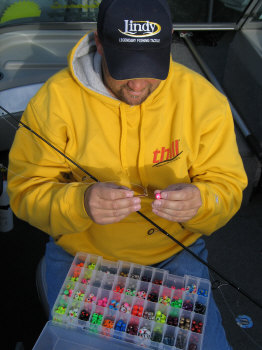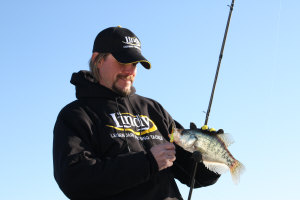Color Up
Category: article
May 26th, 2009 by OutdoorsFIRST
Modified May 26th, 2009 at 12:00 AM
As the second fish in as many minutes thumped a white jig head with a leech, there was a scramble as five hands reached into the open tackle box to find 3/8 ounce heads of the same color. In minutes, two more walleye are flopping on the deck and another rod is bent double – and they say color isn’t that important.
 |
|
|
Lindy X-Change Jig System makes for easy jig weight or color changes
|
The scene above took place on a charter trip on Lake of the Woods last fall and it was replayed many times. Jon Thelen could not have asked for a better opportunity to demonstrate the importance of color to schooling walleye. “We were anchored over a school of fish that numbered in the hundreds,” says Thelen. “I had a tray with all the X-Change Jig System colors in 3/8 ounce. Everyone started with different colors, but as soon as someone caught a couple of fish we would all quickly switch to that color and start catching.”
It is a common occurrence that most fishermen never quite understand. Fish congregate in giant schools but after biting well for a short time, they seem to lose interest even though they are still present on the sonar. Anglers then settle for moving on to find “active” fish, assuming they have caught all the active ones out of that school. But why not catch the same ones?
“Walleyes are often very color sensitive,” says Thelen. “If I am graphing fish, color is one of my most important adjustments. A school of fish will eventually stop biting on a specific jig, but by changing quickly you can often trigger another bite or activate the whole school.”
 |
|
|
Let the Fish Decide which color is best in a given situation
|
Understanding the importance color plays in convincing dormant or resting fish to feed actively is paramount to success on big ‘eyes – especially when they gather in numbers as the water cools. The ability to change often and quickly offers a distinct advantage. That’s why the X-Change jigs from Lindy shine in this situation.
“It allows me to fish multiple colors in an hour; sometimes as quickly as a different color every five minutes,” Thelen says. “If I had to cut and retie for each change, I might only get through half as many colors – especially in windy conditions when retying can be difficult.”
Walleyes swimming in northern waters are not the only fish that show color preferences. Crappie in muddy Southern reservoirs are equally concerned with it.
When Todd Huckabee takes clients out looking for big slabs on Lake Eufaula in Oklahoma, he wants them to have a blast and catching lots of fish is often the key to that. By using two jigging rods per person with two jigs on each line, Huckabee can quickly key on which color combinations the crappie are hitting that day and by using the Lindy X-Change Jig System he does not have to waste precious time retying jigs.
“I give my clients a handful of X-Change jigheads so they can switch it up when they are not catching fish,” says Huckabee. “In doing this, I have found that certain colors definitely work better on different days. Yesterday, for example, my client put on a gold head and started stroking them while fishing behind me. I changed and we quickly finished our limit of 74 huge crappie. There were at least ten other boats in the area and they were catching a few, but we wore them out.”
So why is color so important in crappie fishing?
“Crappie don’t look at a chartreuse jig and decide to wait for a blue one,” said Huckabee. “The thing that gets them is that each color shows up in a different amount under water, affecting the appearance of the profile of that jig. In other words, a black jig may catch fish consistently until the sun comes out and the active fish start nailing chartreuse. It is not that the fish decided chartreuse looked tastier than black – they are just able to see it better.”
And that is exactly why Huckabee goes about testing different colors the way he does. “To effectively fish for crappie, you usually want to have three colors so that fish will notice the contrast,” says Huckabee. He’ll start with a hot yellow Lindy X-Change Jig with a black and pink YUM Wooly Beavertail or a pink and white Fuzz-E-Grub and change the jighead as needed. If the jig color doesn’t seem to help, he has the added option of changing to a different color plastic.
Though particulars have been debated ever since lures began being produced in more than once color, there are a few basic color ideas that provide a starting point for anglers wanting to experiment. Gold and Nickel colored jigs are effective anytime, but they especially shine, no pun intended, when the sun is bright as do other metallic colors. Bright colors are good in muddy water or bright sunshine. Green, black, blue and purple are good choices for ultra-clear water.
For average conditions, most any color will work. This is the time when anglers must start with something in which they have high confidence. Always be sure to use different colors for each jig in the water and let the fish tell you which one they want.
The bottom line: color matters. Whether searching for big ‘eyes or slab crappie, every angler should be ready to experiment to find which color the fish prefer. Changing sun, depth, wind or water clarity can all be the key to fish preferences changing and the ability to change quickly can be the difference between a fish every now and then and a boat full of delicious fishes.